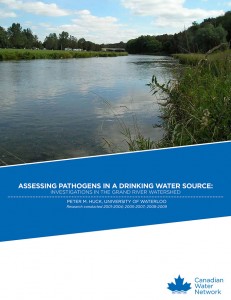Pathogen Loadings at Drinking Water Intakes on a Heavily Impacted River: Assessing Urban and Agricultural Inputs
Principal Investigator - Peter M. Huck, Professor, University of Waterloo (2001-2004)

Challenge
Drinking water utilities have recognized the importance of effective watershed planning (e.g. source water protection) as a way to reduce human health risks from waterborne pathogens. Specific pathogens such as E. coli O157:H7, Campylobacter, Giardia, Cryptosporidium, and viruses require different treatment strategies to render them benign. Water utilities in small watersheds grapple with peak pathogen concentrations, which can be many times greater than baseline levels following rain storms or snowmelt. Livestock operations and combined sewer overflows also contribute to these peaks.
This research program was designed to evaluate both the technical and socio-economic feasibility of programs which reduce loadings from various pathogen sources and process modifications that can make biological disinfection of wastewater treatment more effective. This included measuring peak and baseline loadings of the major types of microbial pathogens. The research was centered in the Grand River in southern Ontario, a watershed which typifies these particular challenges. The key end users of the project research are water utilities and municipal governments responsible for drinking water infrastructure to design more efficient water and sewage infrastructure procedures.
Project
The project examined the contributions of target pathogens from the major sub-watersheds of the Grand River in Ontario, and the relative contributions of non-point (agricultural) sources and municipal wastewater and major combined sewer overflows under peak and normal conditions. The researchers used existing raw water pathogen monitoring data from municipalities in the Grand River watershed. Water samples were routinely collected from 36 locations and analyzed for a range of waterborne pathogens. Sampling was done following storm and snowmelt events at two locations including a drinking water intake.
The research project modified an existing model, WATFLOOD/SPL, to examine pathogen transport. When applied to a sub-watershed, the model predicted that most microorganisms entering streams and rivers from land-based sources would enter from tile drainage systems rather than overland transport. Only on rare occasions did overland transport correspond to the highest observed and modeled microbial concentrations. Rapid increases in measured E. coli concentrations during storm events suggested that the re-suspension of microorganisms from stream sediments may also be important. The research suggests that when monitoring raw water quality, greater attention should be paid to monitoring wet-weather events which may carry greater pathogenic loads.
Researchers also evaluated the Region of Waterloo’s Rural Water Quality Program which encouraged farmers to adopt beneficial management practices to reduce nutrient and pathogen loading. From their assessment, researchers propose that treatment at a utility may be more cost-efficient than monetary incentives (for the protection of human health). A project research study considered whether privatization leads to a more efficient operating structure in water utilities, and found no difference between publicly and privately operated utilities in Ontario.
This project provided the first comprehensive microbial characterization of an important watershed in Canada. It included not only monitoring for various pathogens including bacteria, protozoa, and viruses, but also quantified inputs from agricultural and domestic wastewater sources. The research identified specific contributors of contamination and their potential risk with respect to human pathogens in the target watershed, as well as risks associated with and the importance of precipitation/storm events.
Outputs
- Researchers presented at the “Pathogens in Water Workshop” held in Vancouver in June 2004. This meeting allowed for the exchange of information between CWN projects that had a watershed monitoring emphasis.
- Research findings were also presented to CWN project partners including the Grand River Conservation Authority and the Regional Municipality of Waterloo.
- They were also presented to representatives of the 15 NSERC Industrial Research Chair in Water Treatment municipal, consulting, and manufacturing partners at three annual “Information Days” (2002-2004), and through academic journals. The four refereed publications listed below have been cited by other researchers in their works more than 150 times confirming widespread distribution of this work.
Select Publications
Dorner, S.M., W.B. Anderson, T. Gaulin, H.L. Candon, R.M. Slawson, P. Payment, and P.M. Huck, 2007. Pathogen and Indicator Variability in a Heavily Impacted Watershed. Journal of Water and Health, 5(2):241-257.
Dorner, S.M., W.B. Anderson, R.M. Slawson, N. Kouwen, and P.M. Huck, 2006. Hydrologic Modeling of Pathogen Fate and Transport. Environmental Science and Technology, 40(15):4746-4753.
Dorner, S.M., P.M. Huck, R.M. Slawson, T. Gaulin, and W.B. Anderson, 2004. Assessing Levels of Pathogenic Contamination in a Heavily Impacted River Used as a Drinking Water Source. Journal of Toxicology and Environmental Health, Part A, 67 (20-22):1813-1823.
Dorner, S.M., P.M. Huck, and R.M. Slawson, 2004. Estimating Potential Environmental Loadings of Cryptosporidium spp. and Campylobacter spp. from Livestock in the Grand River Watershed, Ontario, Canada. Environmental Science and Technology, 38(12):3370-3380.
Select Presentations
Dorner, S.M., W.B. Anderson, H.L. Candon, R.M. Slawson, and P.M. Huck, 2005. Estimating Short-Term Temporal Fluctuations of Pathogen and Indicator Levels in a Heavily Impacted Watershed. Proceedings, 11th Canadian National Conference and 2nd Policy Forum on Drinking Water, Calgary, Alberta. pp 409-426.
Dorner, S.M., P.M. Huck, R.M. Slawson, and W.B. Anderson, 2004. Monitoring and Modeling Temporal Variations of Pathogens and Indicators in an Impacted Watershed used for Drinking Water Supply. Proceedings, AWWA Water Quality Technology Conference and Exposition (WQTC), San Antonio, Texas. CD-ROM, paper T8-1.
Anderson, W.B., P.M. Huck, T. Gaulin, S.M. Dorner, and R.M. Slawson, 2003. Occurrence and Distribution of Selected Human Pathogens and Indicators in a Heavily Impacted Watershed. Proceedings, AWWA Water Quality Technology Conference (WQTC), Philadelphia, Pennsylvania, CD-ROM, paper T12-3.
Dorner, S.M., R.M. Slawson and P.M. Huck, 2001. The Use of Modelling to Develop a Pathogen Monitoring Program. Proceedings, AWWA Water Quality Technology Conference (WQTC), Nashville, TN. CD-ROM, paper M8-5.
Dorner, S.M. and P.M. Huck, 2003. Estimating Levels of Pathogenic Contamination from Point and Non-Point Sources in a Multi-use Watershed. Proceedings, AWRA International Congress: Watershed Management for Water Supply Systems, New York City. Jun. 29-Jul. 3.
Dorner, S.M. and P.M. Huck, 2003. Modelling Pathogenic Contamination in a Drinking Water Source. Presented at the Ontario Water Works Association (OWWA)/Ontario Municipal Water Association (OMWA) Joint Annual Conference, Hamilton, Ontario, May 4-6.
Huck, P.M., D. Dupont, A.G. Werker and P. Payment, 2003. Pathogen Loadings at Drinking Water Intakes on a Heavily Impacted River: Assessing Urban and Agricultural Inputs. Presented at the Canadian Water Network First National Symposium, Saint John, NB, Mar. 23-27.
Outcomes
- Results from this investigation provide guidance for planning monitoring programs for water quality and for the development of pathogen fate and transport models to be used for source water risk assessment.
- Changes in practice as the research determined how incentive program components translate into predictions of changes in the number of farms participating. This information can help forecast the average reduction in pathogen loadings from adoption of the best management practices, allowing for granting agencies to quantify these impacts and allocate scarce resources.
- The project also generated a novel approach to the measurement of relative efficiency of operations of water utilities in Ontario. In particular, this part of the project allows us to separate out endogenous factors (ones under control of utility manager) from exogenous factors (ones beyond their control such as weather, population density and raw water quality). Relative efficiency rankings should be based upon factors that managers are able to control.





